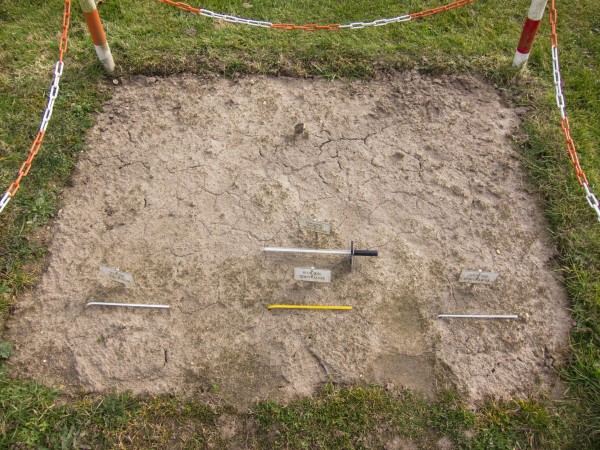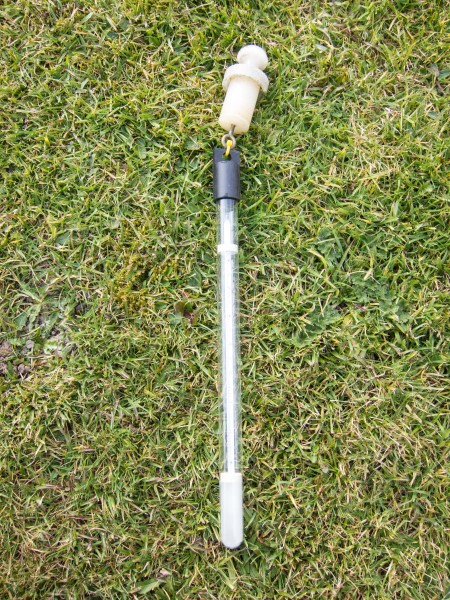Earth temperatures
Earth temperature measurements
Temperatures are measured at six different depths within the soil – at 5 cm, 10 cm, 20 cm, 30 cm, 50 cm and 100 cm below a bare soil or grass surface within the observatory.

Top photograph: The ‘bare soil patch’, housing the bare soil minimum thermometer (top) and the (left to right) 5 cm, 10 cm and 20 cm earth thermometers – March 2016: Photograph Copyright © Stephen Burt.

Bottom photograph:An earth thermometer, shown removed from the tube in which it is exposed at the relevant depth – 30 cm, 50 cm or 100 cm. The 50 cm and 100 cm thermometers are suspended on chains within the tube. Photographed March 2016: photograph Copyright © Stephen Burt.
Climatological measurements of earth temperatures are made using standard, calibrated thermometers. The 5 cm, 10 cm and 20 cm thermometers have a right-angled stem, such that the bulb of the thermometer is exposed at the correct depth underneath a bare soil surface, the stem of the thermometer being at ground level. The 30 cm, 50 cm and 100 cm thermometers are exposed within light grey plastic (30 cm) or steel (50 cm and 100 cm) tubes below a grass surface, the thermometers themselves suspended on chains at the correct depth and withdrawn for reading: the thermometer bulbs are encased in wax, which avoids the thermometer responding too quickly to ambient air temperatures when withdrawn for reading. All thermometers are read once daily at the 0900 UTC observation. If the thermometers are covered by snowfall at the time of reading, the snow is cleared from the stems of the shallow thermometers during the observation so that they can be read, and is then replaced.
Automatic observations of earth temperatures at 5 cm, 10 cm, 20 cm, 30 cm, 50 cm and 100 cm below a grass surface within the observatory are made using platinum resistance thermometers (PRTs), manufactured by Vaisala (model DTS12G1). These are exposed at the relevant depth a few metres east of the liquid-in-glass thermometers, towards the centre of the observatory plot. All PRTs are polled once per second using the Campbell Scientific CR9000X logger: standard ‘meteorological’ output consists of 1 minute averages of the polled PRT values in compliance with World Meteorological Organization specifications.
Period of record available
- Earth 5 cm, 10 cm and 20 cm: daily 0900 UTC observations, January 1961 to date
- Earth 30 cm: daily 0900 UTC observations, January 1910 to date
- Earth 50 cm and 100 cm: daily 0900 UTC observations, January 1971 to date
Prior to January 1971, earth temperatures were measured at 2 ft (60 cm) and 4 ft (120 cm) depths. Daily 0900 UTC records at 2 ft depth commenced in January 1911 and 4 ft in January 1924: both terminated in December 1970, being replaced by ‘metric’ 50 cm and 100 cm depth measurements.
University of Reading climatological data
Sensor manufacturer link:
Vaisala platinum resistance thermometers (PRTs)
This page updated February 2018